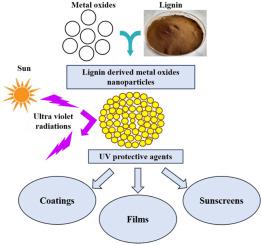Journal of Cleaner Production ( IF 9.7 ) Pub Date : 2021-07-16 , DOI: 10.1016/j.jclepro.2021.128300 Ravneet Kaur 1, 2 , Sanjeev K. Bhardwaj 1 , Sanjam Chandna 1, 2 , Ki-Hyun Kim 3 , Jayeeta Bhaumik 1

|
Use of agri-biomass is a promising sustainable approach for the production of functional materials while utilizing agro-biomass at the same time. In this respect, lignin derivable from agri-biomass is an economic source to generate functional biomaterials with the biocompatibility and sustainability. As such, lignin has been favorably utilized as a raw material for the preparation of various substances including metal oxide nanocomposites (MONCs). As is the case of MONCs, the applicabilities of lignin-derived MONCs should be extendible to versatile fields [e.g., Ultraviolet (UV) protection, photocatalysis, and antimicrobial agents]. Fabrication of lignocellulosic biomass as a raw material should be a plausible option for the development of UV protective material from the industrial perspective. This review aims to highlight the notable research findings (e.g., in viewpoint of lignin as an economically and environmentally better alternative to the raw chemical material for MONCs synthesis) made over the past few years. In this respect, our emphasis was placed on the development of lignin-based ZnO and TiO2 composites for UV protective applications. The use of lignin for the synthesis of MONCs is thus found as a significant technological advancement over the existing chemical-based methods. This review will also aid in expanding the future applications of lignin-based MONCs, especially with an emphasis on UV-protecting agents in diverse product forms (e.g., coatings, films, and sunscreen).
中文翻译:

用于紫外线防护应用的木质素基金属氧化物纳米复合材料:综述
使用农业生物质是生产功能材料同时利用农业生物质的一种有前途的可持续方法。在这方面,源自农业生物质的木质素是产生具有生物相容性和可持续性的功能性生物材料的经济来源。因此,木质素已被有利地用作制备包括金属氧化物纳米复合材料 (MONC) 在内的各种物质的原材料。与 MONCs 的情况一样,木质素衍生的 MONCs 的适用性应该可以扩展到多种领域 [例如,紫外线 (UV) 保护、光催化和抗菌剂]。从工业角度来看,制造木质纤维素生物质作为原材料应该是开发紫外线防护材料的合理选择。本综述旨在强调过去几年取得的显着研究成果(例如,在经济和环境方面木质素作为合成 MONCs 的化学原料的更好替代品的观点)。在这方面,我们的重点是开发木质素基 ZnO 和 TiO2用于紫外线防护应用的复合材料。因此,使用木质素合成 MONCs 被认为是对现有化学方法的重大技术进步。该综述还将有助于扩大基于木质素的 MONC 的未来应用,特别是重点放在不同产品形式(例如,涂层、薄膜和防晒霜)中的紫外线保护剂。











































 京公网安备 11010802027423号
京公网安备 11010802027423号